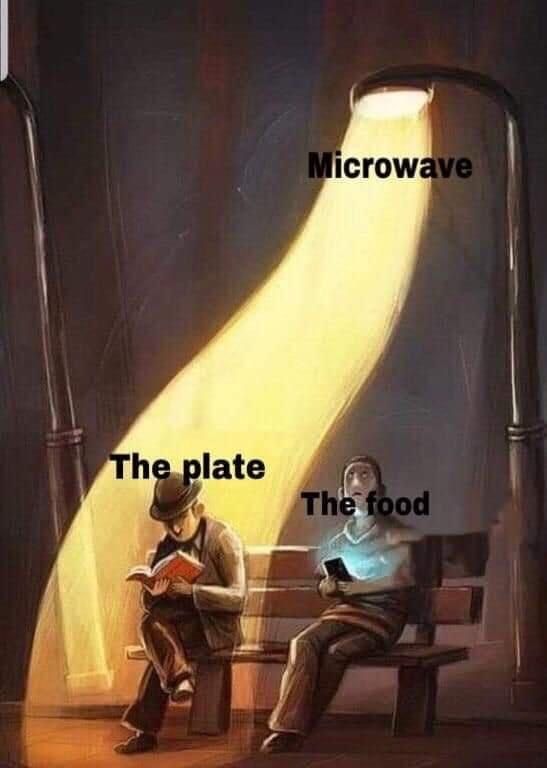this post was submitted on 12 Oct 2023
647 points (96.0% liked)
memes
10440 readers
3885 users here now
Community rules
1. Be civil
No trolling, bigotry or other insulting / annoying behaviour
2. No politics
This is non-politics community. For political memes please go to [email protected]
3. No recent reposts
Check for reposts when posting a meme, you can only repost after 1 month
4. No bots
No bots without the express approval of the mods or the admins
5. No Spam/Ads
No advertisements or spam. This is an instance rule and the only way to live.
Sister communities
- [email protected] : Star Trek memes, chat and shitposts
- [email protected] : Lemmy Shitposts, anything and everything goes.
- [email protected] : Linux themed memes
- [email protected] : for those who love comic stories.
founded 1 year ago
MODERATORS
you are viewing a single comment's thread
view the rest of the comments
view the rest of the comments

[Edit: I went and read a scientific article about this and actually a lot I wrote here is wrong. Basically microwaves work by heating the water in the food by making the water molecules oscillate with the waves. (Ref: http://www.sfu.ca/phys/346/121/resources/physics_of_microwave_ovens.pdf skip the part about how a magnetron generates microwaves and how frequencies are limited by the dimensions of the waveguide if all you care about is how the heating works). It's not at all the mechanism I thought and my conclusions are all off. This would mean that as somebody pointed out it's the humidity in the plate causing it to heat, which woukd explain why it happens with earthware.
The bit about which plates work best or not for me is correct as it's experimental, as is the thermal conduction stuff because I actually learned that at Uni rather than presumed from what I knew (a totally different mechanism were photons are actually absorbed, which is not at all how microwaves heat food)]
~~It's to with the relative ability of materials inside that microwave to absorb that frequency of microwaves: the microwaves just bounce around in that compartment until they get absorbed, and those materials with a higher absorption ability for microwaves at the frequency used in microwave ovens ("microwave" is a whole range of frequencies and those ovens are tuned to emitting just a specific frequency) will end up "taking" a higher proportion of them (and hence of energy) than the other materials and thus heat up more.~~
~~If the difference in absorption rates is big enough you end up with a situation where one things is absorbing 90% (or a similarly large fraction) of the energy bouncing around as microwaves in that oven and leaving only a smaller fraction for the rest, and hence heating up a lot more.~~
~~You get a similar thing if you put, say, cheese on toast next to a glass of water in your microwave oven: that cheese, which is mainly fat, will melt like crazy and the water will barelly have heated up, because water is nowhere as good as fat in heating up (I believe, but am not sure, that the actual frequency chosen in the microwave spectrum for use in microwave ovens was the one that fat best absorbs)~~
~~That plate of yours probably is some kind of ceramic material with metal particles in it, so it's better at absorbing the microwaves than the food, hence the plate captures most of the microwaves (so, most of the energy pumped into that chamber), hence heats up much more than the rest.~~
The termal conduction between the materials with different microwave absorpion rates that heat differently in that microwave will tend to equalize the temperature over time, but unlike with the fat which is part of the food itself and thus will quickly equalize temperature with all the other stuff around it (such as with the water in the food but not, as in my example above, water in a glass which is separated from it), the food and the plate are only in contact is a very limited area (were the food touches the place) so the temperature equalizes much slower between both.
Try a different kind of ceramic (in my experience that problem happens mostly with earthware, so try finer ceramic materials) or glass plates.
In the meanwhile if using the current plates, you can just use a lower power setting in that microwave oven to give more time for the above mentioned process of the temperature equalizing by conduction to move the heat from the plate to the food, spread the food better on the plate to have a higher the area of contact and thus more the thermal conduction for heat transfer between plate and food, or just leave the plate there with the food for a little while after the heating cycle is over so that more of the heat is conducted from the plate to the food before you take it out.
Ok, now convince that your entire rant wasn't just a language learning model's hallucination of what sounds like a reasonable explanation, but doesn't actually make any sense or have any grounding in reality. Because that's what it sounds like. I was going to start picking apart your explanation, but there's just so much wrong and inconsistent that I gave up.
I'm glad I'm not the only one who thought this. Their explanation is weirdly verbose yet conceptually wrong on almost every level. There's been a lot of people in this thread who fundamentally don't understand how a microwave works in general to be honest.
It's funny, several people arguing about how a microwave doesn't work because none of them know how.
Yeah, turns out most of what I thought about the process by which the food heats was bollocks.
Reference: http://www.sfu.ca/phys/346/121/resources/physics_of_microwave_ovens.pdf
I've edited my post.